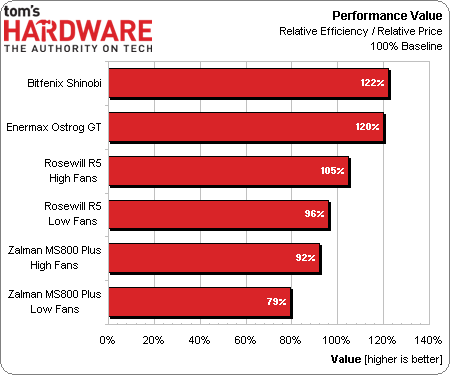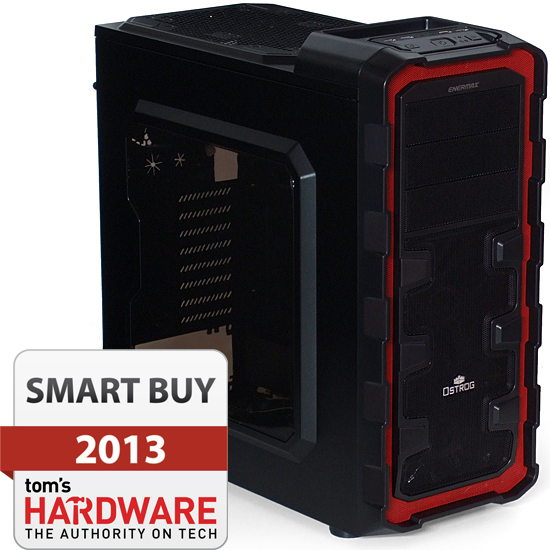Four More Sub-$100 Cases For Your Gaming Build, Reviewed
Our second group of value-oriented cases looked good in the photo preview, but we really wanted to see how they’d perform with a load of hot gaming hardware. Will these beat their predecessors in terms of quality, feature, hardware support, or value?
Which Of These Four Cases Takes Top Spot?
Why you can trust Tom's Hardware
Coincidentally, the alphabetic order in which the cases are arranged coincides with lowest price first. That certainly makes a nice-looking chart, since it’s difficult for any company to come up with a 5% performance advantage to overcome its $5 price disadvantage. With the average of all cases as the 100% baseline, we can see that BitFenix’s low-cost Shinobi tops the chart by 22% over-average.
BitFenix sells the third-place performer in today's round-up, and it uses a $5 price advantage to beat the second-place performer from Enermax. That company's Ostrog GT is the only case in our comparison to include an eighth slot. I recommend the eighth slot to anyone who builds serious gaming machines and occasionally swaps motherboards, simply because some motherboards have a PCIe x16 slot at the bottom. Performance-oriented graphics cards usually need two slots.
Enermax has a few other features that help justify its $5 premium, such as the pair of intake fans that help with its second-place performance finish, along with its dedicated SSD cage (even though it appears to have been tacked onto an older chassis). But I can’t hand an award over to Enermax just yet.
Next up on the value chart is Rosewill’s R5. The R5 can hold up to three times as many SSDs as the Ostrog GT, though most enthusiast-class machines top out at two anyway. The R5 also has flapped rubber grommets covering all of its cable passages for a cleaner appearance. Its incompatibility with slightly-oversized motherboards could be an issue, however, and its performance left a little to be desired.
At the top of the performance heap, Zalman’s high-end MS800 Plus takes last place on the performance-per-dollar chart only because it falls just within our $100 limit. This is one of the cheapest high-end cases I’ve seen, so a performance-to-price comparison with mid-quality parts isn’t exactly fair. And, as much as it might be the perfect case for many of us, a perfect gaming case should at least have an eighth slot. I’m also concerned that the shape of the motherboard tray might block access to some of the SATA ports on slightly-oversized platforms, such as the previously-qualified Asus P9X79 WS. Over the years, we’ve seen several 10.5”-wide boards marketed specifically towards the mid-budget enthusiast market.
So the highest-quality case in today’s comparison, Zalaman’s MS800 Plus doesn’t win our top prize simply because it’s not specifically designed for mid-budget gamers. Enermax’s mid-market Ostrog GT has the performance and features to make it the value-oriented pick over BitFenix’s less-expensive Shinobi, so the Ostrog GT gets our "Smart Buy" award.
Current page: Which Of These Four Cases Takes Top Spot?
Prev Page Temperature, Noise, and Acoustic EfficiencyGet Tom's Hardware's best news and in-depth reviews, straight to your inbox.
-
jdwii Why no love for coolermaster its easily the best Case company out there, i rarely even consider anything else. For just 60$ they offer one heck of a deal.Reply -
Crashman jdwiiWhy no love for coolermaster its easily the best Case company out there, i rarely even consider anything else. For just 60$ they offer one heck of a deal.Tom's HardwareOf the 28 companies we invited to participate, 11 responded with cases they thought would give the Tom's Hardware audience the best balance between quality, features, and price. We divided the round-up into three groups based on when each of the samples arrived.Reply -
griptwister Wow! Looking for a new case! It's time to upgrade my Antec OneHundred windowed. it's too loud with all the fans. and the PSU. Looks like I'll be going with a Zalman MS800 for my next rig! I liked the look of the z11 better at first, but seeing what the MS 800 looks like with a few LEDs, it seems classy and sleek yet not overdone. Great review THW!Reply -
slomo4sho Thank you for not doing a slide show for this like the other reviews.Reply
Also, still looking forward to a review of the Cooler Master HAF XB. -
dalmvern slomo4shoThank you for not doing a slide show for this like the other reviews. Also, still looking forward to a review of the Cooler Master HAF XB.Reply
Apparently you were unaware of the slideshow they released last week. What Toms has done with all of these round ups was take the pictures and post them, then once they get done with their battery of tests they post the results and commentary afterward. -
nd22 Excellent review! I like to get the best possible performance for the money I spent and it seems that these cases you reviewed are perfect for a mid-end gaming build I am planning to do! How about some exotic cases to review for us Tom? For example I would like to see a review of cooler master haf xb or fractal 304.Reply -
sincreator It's about time Zalman sent you guys one of their budget oriented cases. I bought the Zalman Z9+ for $34.99 last year with free shipping from NCIX, and I absolutely love the case. Great quality with a huge amount of features for a case of that price. It has more features than my brothers Antec 900 surprisingly, and it probably should of been $70-80. I'm not complaining though. lol. I have recommended the MS 800 and the Zalman Z9+ to a few friends, depending on their budget. They all loved the cases and were shocked at what they got for the money. I'd love to see more reviews for Zalman's cases on Tom's.Reply -
ubercake Ok. Where are the Tom's models?Reply
Inner butt cheek. Side boob. That's what's going to sell cases. :) -
Crashman ubercakeOk. Where are the Tom's models?Inner butt cheek. Side boob. That's what's going to sell cases.Sorry, all the models near this location are BBW. I don't believe that would go-over with the majority :pReply


